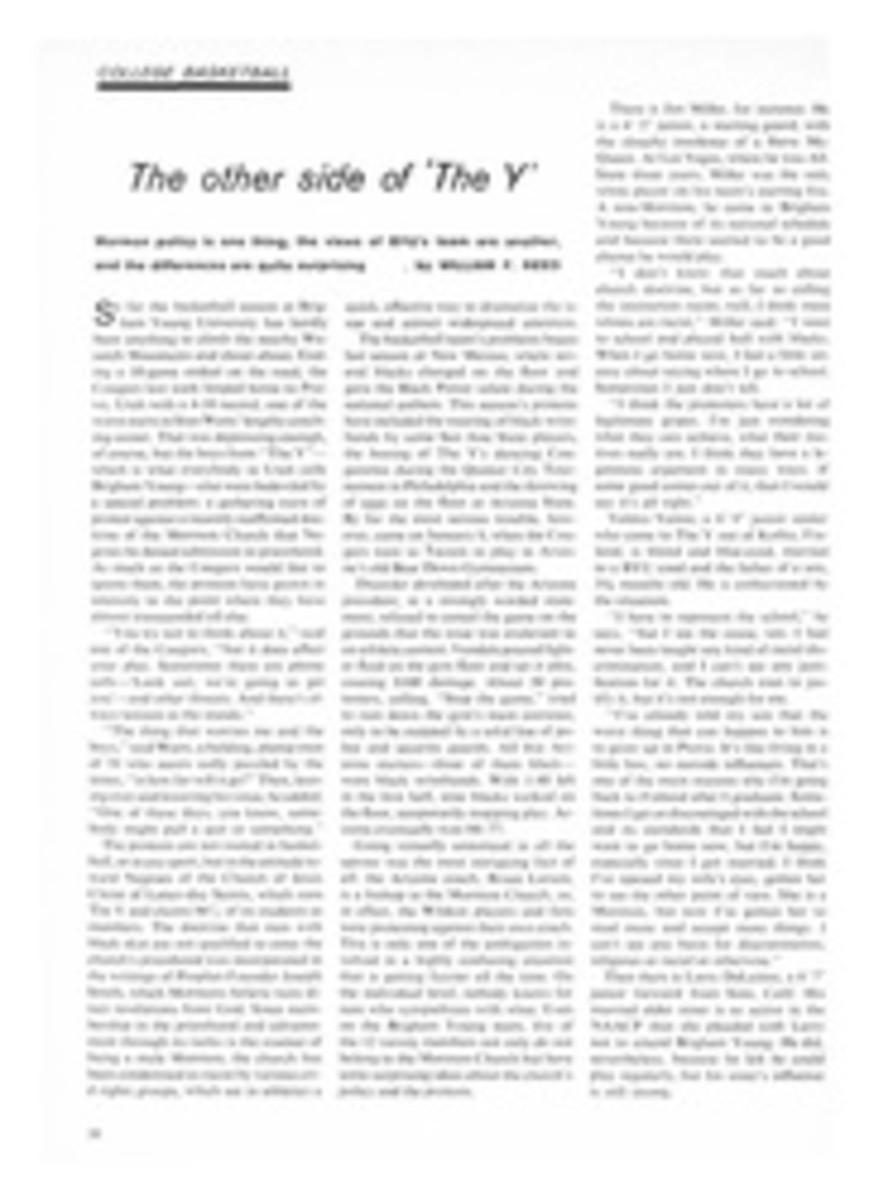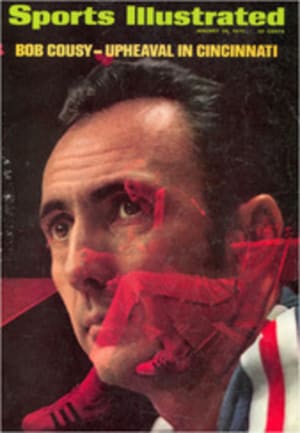
Hot tips for cold days
Last year some 17 million Americans turned the nation's public camping grounds into a season-long traffic jam. This year their numbers will be even greater. So, too, will the volume and variety of the equipment they take with them from air-conditioned travel trailers to a sophisticated array of creature comforts worthy of the yacht Christina.
If this return to nature—or its reasonable 1970 facsimile—brings smiles to the camping industry, it brings only a philosophical shrug from James Gilbert Phillips, a long, lean New Mexican who has challenged the entire concept of camping as it is practiced today.
"The indoors has no place on a camping trip," Phillips says. "It should be left home where it belongs. The forest was once man's haven. He should be able to venture back into the forest and enjoy the wonders and beauty that have always been there. He should be able to live in comfort for short periods of time with a minimum of equipment and with complete confidence in his ability to meet the challenges of any wilderness."
For most of his 49 years, Phillips has practiced what he has been preaching for the past 11. His role as the prophet of primitive camping began in 1958 when he became scoutmaster of Santa Fe Troop 23 of which his son Jim, then 10, was a member.
The troop was soon performing feats most boys only read about. With nothing but the clothes on their backs, flint and steel, a couple of empty cans and pocketknives, they spent periods of from two to seven days in the Sangre De Cristo Mountains sleeping on self-fashioned beds of branches and boughs. At 10° below zero and with high winds drifting snow to 20 feet, they crossed the 12,000-foot Truchas Divide, building snow-block windbreaks for shelter each night.
One of Phillips' most practical, albeit radical, rules of wilderness camping, especially in winter, is to eliminate the need for fire. He stresses the fact that fire is luxury and not essential to survival, safety or even to simple comfort. Too often campers build fires when they should instead be building shelter. In snow or rain, fires are extremely difficult to start and even more difficult to keep burning. Aside from psychological value, they are virtually useless in severe temperatures to anyone trying to sleep through the night without other shelter.
Fire is unnecessary for cooking, since Phillips' ideal wilderness diet requires none. His menu, which is the same for all meals, consists of equal parts of dried meat, raisins, cheese, shredded coconut, bran and nuts. The mixture is not exactly gourmet fare but it is considerably more appetizing than it sounds, and surprisingly satisfying.
Water, which can take some finding on summer camp-outs, is always available in winter wherever there is snow. On his earlier trips Phillips used to suck on snow whenever he became thirsty, but he soon found that this caused his lips to swell and crack. Now he and his scouts carry plastic or rubber ice bags, which they fill with snow and place inside their shirts against their bare skin. The packs soon warm up to body temperature, which eventually melts the snow inside.
The wilderness clothing and gear Phillips has devised over the years is even more radical than his diet. Phillips, who works as an electrical engineer with the Eberline Instrument Corporation in Albuquerque, is involved almost entirely with nuclear research. He would like to say that his wilderness gear was developed with comparable scientific research, but in truth it evolved by pure hit or miss. At first he dressed for winter camping the way most woodsmen and hunters do: heavy underwear, sweaters, quilted jackets, boots and socks. And like most woodsmen and hunters, he found himself less than comfortable. Keeping his feet warm was his biggest problem. He tried various sock combinations, felt innersoles and insulated boots. Nothing seemed to work in severe temperatures. Finally, on a frigid trip outside Santa Fe he tried to restore circulation to his numb feet by wrapping them in a one-inch piece of polyurethane foam. To his surprise, as the night grew colder his feet grew warmer. Today no Phillips' follower ventures into the wilderness in anything but this type of mukluks, and nobody complains of cold feet. "Polyurethane was readily available, inexpensive, easy to work with and light to transport," Phillips says. "I began using it for everything—pants, jacket, mittens, hat and bedroll. Some of those outfits looked wild, but they worked."
To prove how well they worked, Phillips put them to severe tests. Two years ago, with only a backpack, snowshoes and his Siberian husky, Aztec, he traveled into the Idaho Primitive Area to talk to the legendary Buckskin Bill (The Last of the Mountain Men, Oct. 3, 1966). Because dogs were not permitted on the buses out of Boise, Phillips hitchhiked the 90 miles to McCall. Then he took a ski plane the remaining 40 miles to Warren, a small gold-mining settlement. Buckskin Bill lived another 24 miles beyond, across the formidable Burgdorf Summit. To the handful of settlers in Warren, Old Bill might just as well have lived 2,000 miles away—in winter. The snow was piled as high as the houses in the town.
Phillips spent a few hours in Warren patiently listening as the village elders warned that he could not cross the pass. They told him not to go: "If you get hurt," they said, "we can't help you. If you get lost, we can't search for you. But if we happen to find your body in the spring, we will bring it out."
On that happy note, Phillips set out the next morning on a crossing that rarely had been made in winter. It took him three days. "I knew there would be nothing there that I had not encountered back home in my own mountains," he says. "And I knew my equipment and myself. It was not an easy trip. The drifts in some of those windrows were fierce. But it was no more difficult than I had expected."
In his quiet way, Phillips passes lightly over the hairier moments of his trek. At one point he slipped off a ledge, catching his backpack on a branch where he hung upside down until he could reach a knife and cut himself free.
When Phillips finally arrived at Buckskin Bill's cabin on the shores of the River of No Return, the old man, like any sane hermit, was inside by the fire. He answered Phillips' knock and incredulously peered at his unexpected visitor.
"How'd you git here?" he asked.
"Over the pass," Phillips said.
"Well, praise God," the hermit chuckled. "There's still somebody out there with a little adventure left in his soul."
Phillips stayed a week with Bill, listening to the lessons the old man had learned from a lifetime in the wilderness. Phillips' only disappointment, if it could be called such, was that he had found the weather in Idaho too warm. The temperature had never dropped lower than 10 below zero. For the ultimate test of his gear, he wanted weather much colder. He came closer to what he was looking for last winter in Barrow, Alaska.
In the two weeks Phillips and his son camped on the frozen Arctic slope at Barrow they spent much time with the Eskimos and even took a troop of Barrow scouts—all Eskimos—camping out on the pack ice, reacquainting them with many of the survival arts of their people which have been lost in the television and transistor age.
Although the weather in Barrow was still not cold enough for Phillips—the temperature often went as high as 20° below zero—the trip was an invaluable test of his equipment as well as an opportunity to study Eskimo clothing. Phillips is convinced, as are many other cold-weather experts, that Eskimo dress is still the most functional and practical in extreme cold. His own gear is based on the Eskimo concept of keeping all clothing large and loose-fitting.
Fur mukluks have always been the Eskimo's cold-weather footgear. Phillips' foam, covered with canvas to permit the escape of moisture, works on the same principle. But the Eskimos he noticed in Barrow added a moccasin-type sole of sealskin to combat the moisture of sea ice. Phillips made a similar adaptation on his own mukluks by replacing the canvas soles with rubber bottoms cut from an old pair of galoshes.
This, like dozens of other small but significant innovations, has all been incorporated into Phillips' present cold-weather wardrobe.
All the rest of his clothing is made of sheets of foam: one for each leg, a double thickness cut like a three-cornered diaper for the seat, another flat piece rolled into a tube for the torso and two for the arms. Each slab of foam is simply wrapped around the body and held in place by the outer clothing. Of necessity, the latter must be baggy enough to allow ample room for the foam, but it need be no heavier than a thin pair of flannel sweat pants and a flannel shirt. For extreme conditions, Phillips adds an outer parka.
His headgear is a piece of foam glued into an open-top crown with earflaps or, for sub-zero weather, a head-tunnel which is merely a foam bag with a funnel-like opening kept in shape by a wire coat hanger. The finished product looks much like the Eskimo's hood and ruff.
Mittens, like sleeping bags, are merely foam envelopes. The fancy ones have separate thumbs, but a thumb is not necessary. "They're clumsy," Phillips admits, "but after awhile you get a certain amount of feeling through the foam which makes it possible to do most jobs."
Although Phillips and his scouts still make everything they take and wear into the wilderness, for the first time this year some of these items are also being manufactured commercially. In Santa Fe the fledgling Ocaté Company, headed by a young camping specialist named Steve Perin and backed by L. J. Reynolds, once the major stockholder at Eberline, has taken Phillips' ideas, refined them and is now producing foam clothing and sleeping bags in bright colors and at very appealing prices.
Officially Phillips has no role in Ocaté. Although 90% of the company's production is based entirely upon his ideas and innovations, it has never occurred to him to ask for compensation. This total disinterest in self-aggrandizement is as characteristic of Phillips as is his almost compulsive desire to propagate his wilderness gospel. If Ocaté can help, that is all the compensation he wants.
"Each year dozens of people are lost in this country's wildernesses," he says. "And each year, many of them are never found. Every life lost could be saved with common sense and some basic wilderness knowledge."
But even more basic and fundamental than this, Phillips is teaching that the best way to convert boys into self-confident young men is to give them a chance to prove themselves. A boy who can leave civilization without food, bedding or special equipment and shelter and feed himself in the wilderness with no weapon but his wits is likely to consider himself a man. For Phillips, that is reward enough.
PHOTO
A WELL-INSULATED PHILLIPS READIES HIS PACK FOR AN OVERNIGHT WINTER HIKE

